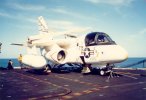This one had something to do with a tail hook failure during a log hit. I don't really know what went wrong with it, kmac can probably explain better.
Sorry for the delay; I was out in California enjoying life. Now I'm back in Texas. As far as the plane with the broken hook, I'll try my best to explain it without using diagrams.
From the cockpit: Everything seemed normal until immediately on the trap, the pilots saw some kind of object fly past the plane (down the LA). When they were told to taxi backward and to raise the hook, nothing happened. Again they were told to raise the hook, but the hook handle was already up. That's when someone on the deck noticed what had happened.
A word about the C-2 tailhook: There are four attachments on the tailhook truss between the actual truss and the aircraft. Each side has a shear bolt (truss pin) that actually holds the hook onto the aircraft. Another point is for retracting the hook, which lifts and then locks the hook with a j-lock. The final point is a dampener which ofcourse dampens the hook on touchdown (and helps prevent hook skips).
From the tailhook truss assembly: Upon touchdown, the hook snaps on one leg engages the wire, and pulls the aircraft to a stop. But what really happened (as shown by the engineering investigation) was much more dramatic. When the hook hit the deck, the dampener acted as a stiff member rather than its job. Somewhere in the life of that part, the parts weren't put together properly. The force of the deck pushing up on the hook, along with the resistance pushing down on the truss assembly (from the bad dampener) created a large moment that sheared the starboard portion of the truss. At this point the hook engaged the wire, therefore putting a linear pull on the hook. Because only one side of the truss was now attached to the aircraft, there was a large moment around the port truss pin. This pin is designed to shear off when there is an excess load, as is the case if the arresting gear on the ship is set too high. By shearing off, the aircraft can have enough speed to continue to fly on the bolter. In this scenario however, due to the assymetric loading, the bolt head popped off and the bolt started to slide through it's attachment rings. This is where it jammed. Most likely, the pilots saw the bolt head flying pass them down the LA. There was 3/4" of the remaining bolt left that jammed.
Big picture: When the hook engaged the wire, the aircrafts speed greatly reduced. It is possible that if the truss pin performed as it was intended to, the aircrafts speed would have been too slow to continue on the bolter, but much too fast to stop on the deck. In other words it is likely that because the truss pin "failed" incorrectly, and that 3/4" remained, there wasn't a Class A mishap. It's a good thing, as they were out there for CQ, with the switch pilots in the back. I want to say that there were 10 souls aboard.
If I have made an error on any of these notes, please forgive me. It has been a while since having to deal with the 4 HMRs that were generated from this.





 irate_12 she was an Angel from above
irate_12 she was an Angel from above 
